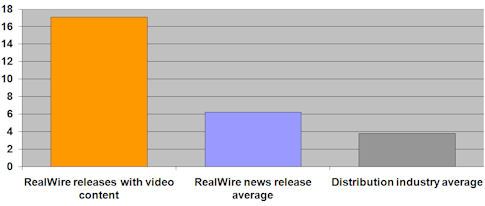News releases including video content achieve three times more coverage than releases without multimedia content. We look at latest research into pick-up of online press releases.
Average pieces of coverage for releases with at least one pickup
.jpg)
There has been much made over the last few years of the benefits of multimedia content, and in particular video, to the likely impact of a company’s news releases. Press release distribution company RealWire recently analysed the coverage achieved by releases which include video content and compared it with those that don’t.
For those releases with editorial or blog coverage, the average number of pieces was 17.1 for the releases with video content. This was almost three times the figure for the sample without video content of 6.2 and four-and-a-half times more than the distribution industry average of 3.8 pieces.
Pickup rate i.e. minimum of one piece of editorial/blog coverage

In March 2010, the related multimedia content of almost 3,000 news releases was examined that were sent across six different distribution services. This study found that less than two per cent had related video content.
At the time of this previous study Adam Parker, RealWire’s chief executive, attributed the lack of adoption of video to the barriers that existed such as the prohibitive cost of some distribution services, a lack of planning and collaboration between different marketing disciplines with regards to sharing relevant content and an apparent skills gap where video creation was concerned.
Commenting on the latest research Parker said: “The coverage analysis implies that including video content with a news release dramatically increases its impact. In part this may be related to its ability to make your story stand out and at the same time provide another form of content for people to find and share in relation to it. Certainly with YouTube being the second most popular search engine it is not surprising that in over 94 per cent of the releases studied that included video, PROs opted to host their related video on a social media sharing site and then embed the content in their release page.”
However Parker is not convinced that this is the whole story. “Another reason for the enhanced coverage could be that video content often seems to accompany news releases that are broader in interest and more conversational in nature compared to the majority of corporate announcements. This suggests that it isn’t simply the act of adding a video that potentially leads to improved coverage in many cases, but also the nature of the underlying story itself.”
So perhaps video content is not an appropriate investment of time for all news releases, but given the significant impact on coverage the continued low frequency of use suggests that it may still be a missed opportunity for many.
Methodology
The research was based on a sample of 124 news releases that included related video content that were distributed and tracked by RealWire (www.realwire.com) during the period September 2010 and July 2011. The combined editorial and blog coverage these releases achieved was compared to the results of 965 news releases that didn’t include video content. The figures of the distribution average were from an independent study carried out in 2008: survey September 2008.
PR Masterclass: The Intersection of PR and GEO
Join PRmoment for a Masterclass featuring 10 of the industry’s foremost experts. You will walk away with a clear, actionable strategy for adapting your content to an AI-first search environment.
Taking place on Wednesday 25th February in London, both virtual and in person tickets are available.
Early bird ticket sale ends Friday 9 January.
PR MasterclassIf you enjoyed this article, sign up for free to our twice weekly editorial alert.
We have six email alerts in total - covering ESG, internal comms, PR jobs and events. Enter your email address below to find out more:









